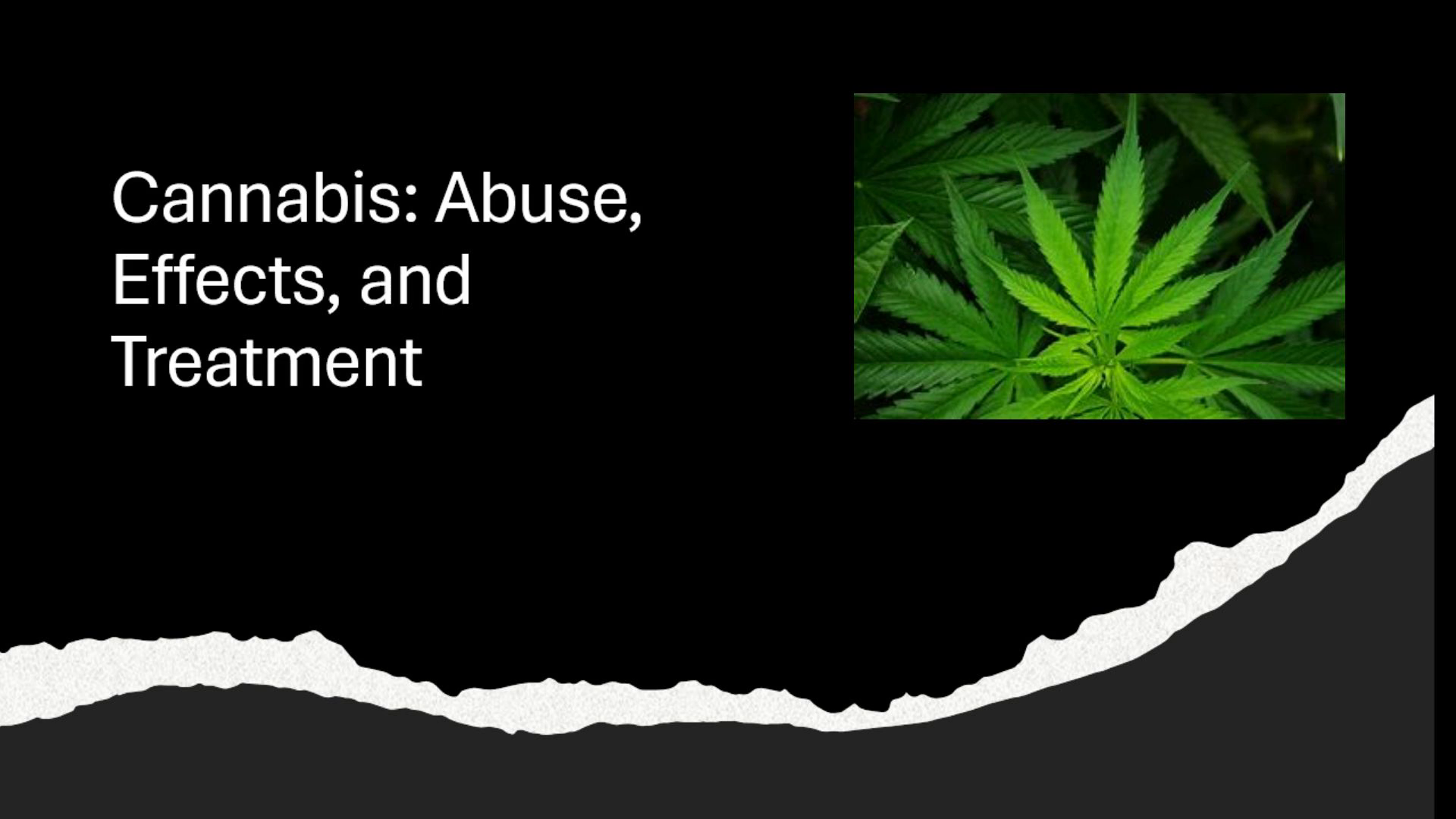
Cannabis: Abuse, Effects, and Treatment
Scene 1 (0s)
Image result for cannabis. Cannabis: Abuse, Effects, and Treatment.
Scene 2 (23s)
Introduction to Substance. Cannabis is commonly known as marijuana. Derived from the Cannabis sativa plant. Contains psychoactive compound THC. Popular for recreational and medicinal use. Classified as a Schedule I drug. Legal status varies across regions (Connor et al., 2021)..
Scene 3 (44s)
History of Abuse. Ancient use for medicinal purposes. Popularized in the 20th century. 1930s: Criminalization in the United States. 1960s: Surge in recreational use. Recent trends show increasing legalization. Ongoing debates about its safety and use (Petrucci et al., 2020)..
Scene 4 (1m 6s)
Prevalence and Epidemiology in the US. Most commonly used illicit drug (Kesner & Lovinger, 2021). High usage rates among adolescents and adults. Increased use during the COVID-19 pandemic (Bartel et al., 2020). Significant number of cannabis use disorders (Connor et al., 2021). Legalization impacts usage rates. Public health concerns persist..
Scene 5 (1m 35s)
Risk Factors/Vulnerable Populations. Adolescents are highly vulnerable (Dhein, 2020). Individuals with psychological disorders (Urits et al., 2020). Self-isolation and stress increase use (Bartel et al., 2020). Genetic predispositions contribute to abuse. Socioeconomic status influences access and usage. Peer pressure and social acceptance..
Scene 6 (1m 52s)
Short-term Side Effects of Cannabis Use. Euphoria and relaxation. Altered perception of time and space. Impaired memory and concentration. Increased heart rate and appetite. Dry mouth and bloodshot eyes. Anxiety and paranoia in high doses (Choi et al., 2021)..
Scene 7 (2m 16s)
Long-term Side Effects of Cannabis Use. Cognitive impairment and memory loss (Kesner & Lovinger, 2021). Increased risk of mental health disorders (Urits et al., 2020). Respiratory issues from smoking. Potential for addiction and dependency. Decreased motivation and productivity (Petrucci et al., 2020). Adverse effects on brain development in adolescents (Dhein, 2020)..
Scene 8 (2m 39s)
Signs and Symptoms of Abuse upon Assessment. Image result for marijuana use symptoms.
Scene 9 (3m 0s)
Potential for Overdose or Use as Suicide Weapon. Low risk of fatal overdose. Risk of severe anxiety and psychosis. High doses can lead to panic attacks. Chronic use linked to suicidal ideation (Connor et al., 2021). Co-use with other substances increases risk. Emergency interventions may be required..
Scene 10 (3m 17s)
Example of a Care Plan: Introduction. Comprehensive care plans are essential. Address both pharmacological and non-pharmacological needs. Tailored to individual patient requirements. Focus on harm reduction and recovery. Incorporate patient education and support. Regular follow-up and reassessment necessary..
Scene 11 (3m 33s)
Pharmacological Treatment. Limited FDA-approved medications for cannabis use disorder. Naltrexone and gabapentin show promise. Symptomatic treatment for withdrawal. Antidepressants and anxiolytics for co-occurring conditions. Monitor for side effects and interactions. Ongoing research into new pharmacological options (Kesner & Lovinger, 2021)..
Scene 12 (3m 56s)
Image result for Cognitive-behavioral therapy (CBT).
Scene 13 (4m 21s)
Patient Education. Educate on the risks and side effects of use. Discuss legal implications and health consequences. Provide strategies for managing cravings. Promote healthy coping mechanisms. Importance of a supportive environment. Resources for ongoing education and support (Petrucci et al., 2020)..
Scene 14 (4m 40s)
Referral. Refer Refer to specialized substance abuse programs. Connect Connect with mental health professionals. Utilize Utilize community resources and support groups. Ensure Ensure continuity of care with primary providers. Engage Engage family and friends in support network. Encourage Encourage participation in rehabilitation programs..
Scene 15 (4m 57s)
A calendar on top of a flat yellow surface. Follow-up.
Scene 16 (5m 14s)
Conclusion. Cannabis use has widespread implications. Understanding risks and treatment options critical. Tailored care plans improve patient outcomes. Ongoing research necessary for effective interventions. Support systems vital for sustained recovery. Continued public health efforts needed to address use..
Scene 17 (5m 29s)
References. Bartel, S. J., Sherry, S. B., & Stewart, S. H. (2020). Self-isolation: A significant contributor to cannabis use during the covid-19 pandemic. Substance Abuse, 41(4), 409–412. https://doi.org/10.1080/08897077.2020.1823550 CDC (2024, February 15). Cannabis and Teens: Cannabis and Public Health. https://www.cdc.gov/cannabis/health-effects/cannabis-and-teens.htmlNational National Institute on Drug Abuse. (2022, August 22). Marijuana and hallucinogen use among young adults reached all time-high in 2021. https://nida.nih.gov/news-events/news-releases/2022/08/marijuana-and-hallucinogen-use-among-young-adults-reached-all-time-high-in-2021 Choi, J., Chung, J., & Choi, J. (2021). Exploring impact of marijuana (cannabis) abuse on adults using machine learning. International Journal of Environmental Research and Public Health, 18(19), 10357. https://doi.org/10.3390/ijerph181910357 Connor, J. P., Stjepanović, D., Le Foll, B., Hoch, E., Budney, A. J., & Hall, W. D. (2021). Cannabis use and cannabis use disorder. Nature Reviews Disease Primers, 7(1). https://doi.org/10.1038/s41572-021-00247-4 Dhein, S. (2020). Different effects of cannabis abuse on adolescent and adult brain. Pharmacology, 105(11-12), 609–617. https://doi.org/10.1159/000509377 Kesner, A. J., & Lovinger, D. M. (2021). Cannabis use, abuse, and withdrawal: Cannabinergic mechanisms, clinical, and preclinical findings. Journal of Neurochemistry, 157(5), 1674–1696. https://doi.org/10.1111/jnc.15369 Petrucci, A. S., LaFrance, E. M., & Cuttler, C. (2020). A comprehensive examination of the links between cannabis use and motivation. Substance Use & Misuse, 55(7), 1155–1164. https://doi.org/10.1080/10826084.2020.1729203 Urits, I., Gress, K., Charipova, K., Li, N., Berger, A. A., Cornett, E. M., Hasoon, J., Kassem, H., Kaye, A. D., & Viswanath, O. (2020). Cannabis use and its association with psychological disorders. Psychopharmacology bulletin, 50(2), 56–67. https://pubmed.ncbi.nlm.nih.gov/32508368/.